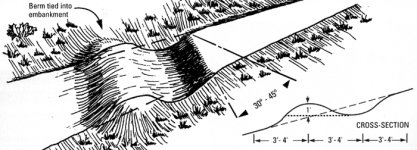Tororider
Veteran Member
The two options that come to mind off the top of my head are put in a "speed bump" to divert rain or cut out some cement and insert a drain to divert water off to the side.
Get some saw chaps. please.
and wear them.
Probably the quickest method would be a speed bump out of asphalt or cement. But the smaller these are the less internal support they have, and would tend to disintegrate fairly rapidly. They do make plastic ones...regardless - I personally am not a fan. Especially if you get a glaze of ice or snow to contend with. Nothing like being stuck in the drive.
The best method, IMHO, would be a prefab trench and grate. Hundreds of manufacturers. Can get with fall built into the trench box. Composites, concrete, steel. Many options. Obviously you need adequate fall fairly close to the edge of the existing drive to whisk the water away. From the picture it looks like this wouldn't be a problem.
Of course, this means making a straight cut or two to create a channel for the trench, a bit of light jack-hammering and the setting of the trench box back into the concrete. Or, just buy the grating and cast the trench with concrete. Lots of options here. I did a google image search and was impressed at the styles that's currently available.
You definitely want fall in the trench to prevent any standing water. No sense in helping out the Mosquitos!!
The two options that come to mind off the top of my head are put in a "speed bump" to divert rain or cut out some cement and insert a drain to divert water off to the side.

I observed that rain runs from the concrete parking pad into the carport. As a result, the bottom of one of the wood carport walls gets wet when it rains. I need to divert the water. Does anybody have any suggestions?
View attachment 341202
Obed
Here is a quick and easy way to remedy MOST of the problem.
First: clean out the joint between the driveway and carport pads (using a grinder if needed).
Second: cut some rubber strips (3/4 - 1" wide depending on the depth of the cleaned out joint) from some rubber inner tubes, e.g. They don't have to be one piece long enough to reach
across the whole length of the joint but can be overlapped.
Third: put some silicone caulk into the joint and imbed the rubber strips on edge into the silicone (overlapping if necessary.) This will leave only about 1/2 inch or so protruding above the concrete.
This will be enough to effectively redirect the water to the side if there is some fall, which there
appears to be.
This thin barrier will go unnoticed when one drives over it and it is resilient enough to return to the upright position after being driven over.
I have even used just the caulk in a 3/8 inch bead to do much the same thing but the rubber would work better in your case, I believe.
HTH
Arkaybee
Hi
I can't speak for how well this idea will or will not work BUT... Do not use a car or truck innertube. After a year in the sun or light, the UV rays will deteriorate the rubber and it will start to break down. If you want this to be a success find another material to use instead of car innertube.
Cheers :drink:
Don
I observed that rain runs from the concrete parking pad into the carport. As a result, the bottom of one of the wood carport walls gets wet when it rains. I need to divert the water. Does anybody have any suggestions?
View attachment 341202